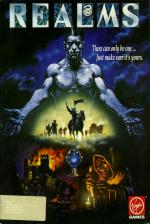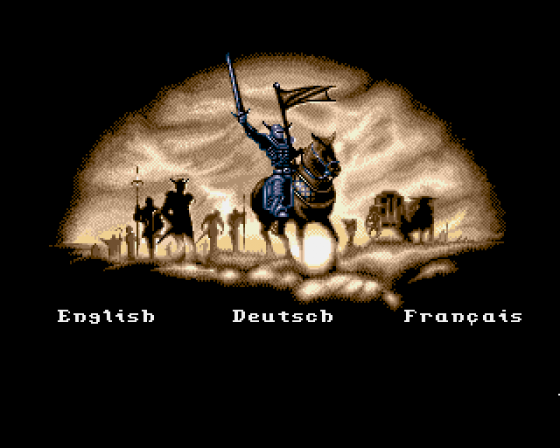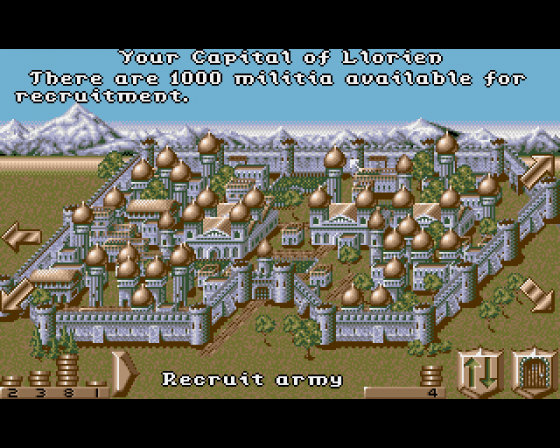
Amiga Power
 1st January 1992
1st January 1992
Realms
The popularizing of strategy continues with Graftgold's 'almost-a-god-sim'. Is this the wargame to beat the phenomenal crossover success of Powermonger?
A year ago the Bullfrog's isometric offering Powermonger set something of a standard for military strategy games, combining the traditional game with the style and presentation of god sims, and lo! The people saw that it was good. It's a year on, and Virgin now seek to further the sub-genre (which currently consists of, erm, Powermonger) with its forthcoming and really ever-so-slightly-similar-looking new release Realms.
Billed as more than a mere god sim or wargame, Realms plunges the budding acolyte into a hodge-podge world of mythical races battling for supremacy - his job is to make sure his realm trounces all the other realms to form one great big realm (hence the title) - and, for once, the billing is pretty accurate. It's not a god sim - you're still a spotty-faced earthlet and unable to visit Populous-style divine wrath upon thine enemy, but your powers do extend beyond those of any real earthly commander. You get to see exactly how all your far-flung forces are faring, for instance, as well as the rather useful ability to instantly issue orders over vast distances.
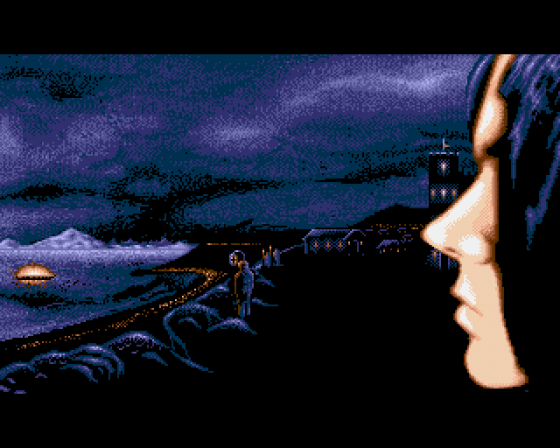
The main thrust of the gameplay is strategic. Set in quasi-Nordic times, your job is to manage the affairs of a capital city, plus smaller cities and ports, while sending out armies to capture enemy cities in a bid to take over the entire game map. Curiously enough, the powers with which you are equipped to achieve this task are handed down by Wotan, not Odin (fact fans may like to note that Wotan is a Germanic name, not Nordic - there's no hard and fast sticking to real history here). As in many things in life, success largely comes down to money. Money to feed and care for the people, recruit and equip armies, build defenses around cities and bribe elements of the opposition into fragile alliance. To make more money, you nobble enemy satellite cities with a view to taking out the capital and absorbing the entire neighbouring realm into your own -"there can only be one..." says the packaging, in true Highlander tradition.
Okay, so how does it play? Well, once you've chosen which realm and thus which race to be - elvish, orcish, Amazonian, barbarian or dwarvish - it's time to build up your forces and resources ready for a spot of annex-'em-up action. There's a fair old bit to do as the game progresses. Not only do you have to keep equipping armies and making sure the peasants are fed, there's the ever present threat of covetous enemy forces sieging your own strongholds too.
Messages on the state of play are relayed via a message crystal which, when he going gets busy, pings away like a thing possessed. It's not a clever idea to ignore this - I found it best to at least keep an eye on the messages coming back as, while I was busily engaged ordering troops about, my city communities were starving and all set for revolt. Salvaging such situations requires much deft manipulation of the various icon-driven control screens. They're not spectacularly intuitive to use and there's much swapping back and forth between them to keep your realm from crumbling - we've certainly seen better.

If by now it's all sounding like an accountant's dream and a psychopath's nightmare, don't fret your blood-crazed sensibilities. There is action to be had when two armies collide, and prety finely tuned it is too. When equipping an army, there's the opportunity to create cavalry or infantry, armed as light or heavy units, and to equip them with a variety of offensive weaponry. Different races have different weapon skills - for example, elves and orcs are hot-shots with missiles - and the reliability of an army comes down to its morale which, as with most things in life, is governed by how much you pay them.
Out In The Blood-Soaked Fields
All this mucking around with weapons and wages becomes relevant on the battle screen. This is the best part of the game; ranging your own units across a close-up view of the terrain while enemy forces leave their positions and prepare to sally forth. Units of your own army can be pointed in any direction (even about-face for a nifty retreat) and made to adopt different formations - things like wedges, phalanxes and our old friend, the defensive square.
Again, the control icons confused me for a while and I had my troops firing arrows at each other while the cavalry went careening off sideways. But, once I'd got the hang of it, the level of control offered over individual units, combined with the speed of the exchange, had me chasing armies around the game world in sabre-rattling glee just looking for a fight (and paying scant regard to the game's main objective).

Speaking of which, Realms does have one or two irritating little foibles up its... wherever its foibles are kept. The obvious course to take in the pursuit of world dominance would be to pick off smaller neighbouring cities and gradually absorb another realm until you can take a crack at its capital city. This is pretty much what the computer opponent tries to get away with. I tried this in the first few of the ten progressively more difficult game scenarios on offer, and while I laud the inclusion of such realistic factors as the morale of foreign races press-ganged into one's own army and the food and health concerns of civilian communities, all this detail tended to muddy the metaphorical waters of my cunning, if piecemeal, plan. Several times, while trying to get disspirited mobs of conscripts off their backsides and into the fray, I became completely bogged down with pinging messages informing me that people in one or another city were starving. This meant leaving the action to muck about buying grain, building up the city and otherwise trying to keep the peasants from storming the Winter Palace. "Ah, but that's the whole point - as realms expand, the greater their internal problems" you may say. Well, yes, fair enough, if we're being realistic about it all, I guess - that's what you get when you give your little computer people a semblance of free will. Me, though - I'd rather have done without all that stuff. I wonder if it wouldn't have been more tactical, wargaming fun without so many extra problems to worry about.
Anyway, back with me playing the game, and what this all boiled down to was that it was high time for a tactical change of tack. A bit of thinking and I found a method that worked too - though, unfortunately, the optimum way of dealing with all this grumbling discontent while swiftly achieving victory rather knackers the earlier levels' longevity of gameplay.
So, the busy tyrant's guide to a quick win: rapidly build up a medium-sized army by levying the bejeezus out of the citizens, head straight for the enemy capitals, raze them to the ground one by one (the opposing forces haven't yet had time to amass a worthwhile army) and boof, that's that.
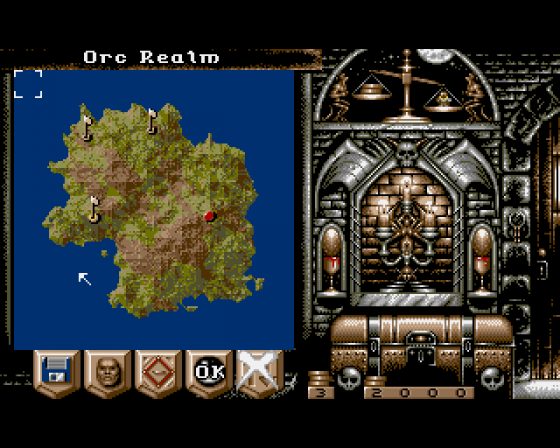
However, as you progress, the game map and the forces ranged against you become rapidly more challenging. Enemy realms become more numerous and more vigorous in their territorial ambitions; fewer resources become available, and the action takes on a frenetic edge as you try to keep armies on target while desperately running around keeping your cities from devolving.
This struggle to keep track of everything while striving for world dominance pitches Realms solidly in the strategy buff's camp, but the battle scenes make for a striking cross-appeal. They're fast, detailed - even the slope of the terrain is taken into account - and you have a direct effect on the course of conflict. There are even dead bodies littered all over the place after an exchange. In fact, the battlefield screen is more of a game within a game, requiring a completely different method of play. Consequently I spent much of the time arranging no-win scenarios in the wider game just so I could mess around with different troop formations and attack tactics in battle.
I like Realms a lot, and (to be honest) I wasn't too sure if I would at first. The game's underlying design philosophy is well sorted, the battle scenes (at least) will appeal to most open minded games players, while the forthcoming extra data disks make it a good long-term bet for any budding imperialist. A specialist taste certainly, but if you even think you might like it, you probably will.
The Bottom Line
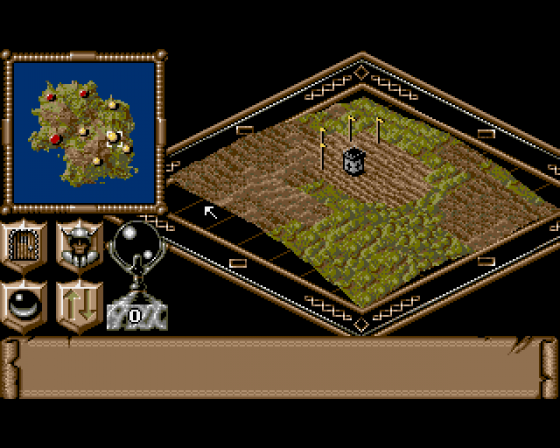
Uppers: An interesting and slickly presented variation on the Kingdoms theme most spectacularly exploited by Powermonger. The great battle sequences really make the game, even if they are a little short in duration. Even the background music takes longer to become an irritating distraction than is usual.
Downers: It gets frustrating at times as there can be just too much routine realm-keeping to manage and, given long enough, the background music will drive you nuts. The control icons could be a bit more obvious.
Basically, a terrific game. It'll take a little getting used to, but Realms offers sufficient brain burn to make it a challenge rather than a drag.

